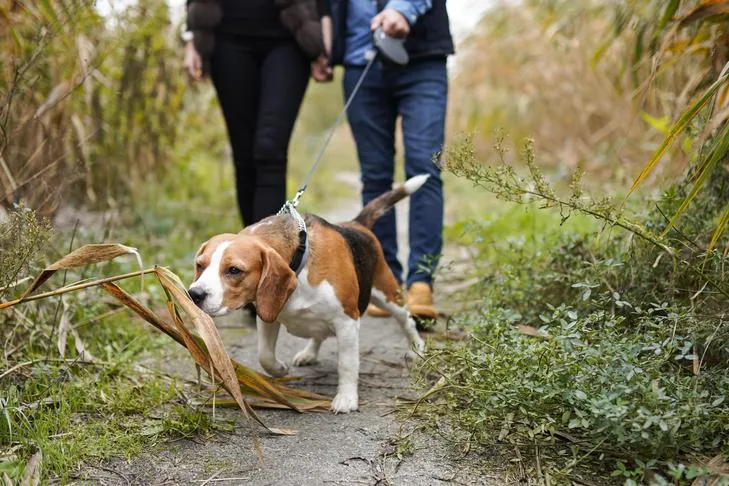Walking your dog should be a joyful experience, a bonding opportunity filled with exploration and shared moments. However, for many dog owners, it often turns into a frustrating tug-of-war, with their beloved canine companion pulling relentlessly. Beyond the annoyance, a dog constantly pulling on the leash can be unsafe for both of you, potentially leading to injuries or unexpected encounters. You might find yourself asking, “How To Train My Dog To Stop Pulling?”
The good news is that leash pulling is a common behavior issue that can be effectively addressed with consistent training and the right techniques. It’s not about forcing your dog into submission, but rather teaching them polite leash manners through positive reinforcement and clear communication. By understanding why your dog pulls and implementing strategic training methods, you can transform chaotic walks into harmonious strolls. This comprehensive guide from Dog Care Story will help you cultivate better leash behavior, ensuring that you and your dog can enjoy every outing together. Learning to teach your dog to stop pulling on the leash is a key step towards a more enjoyable relationship with your pet.
1. Always Reward Good Leash Behavior
Positive reinforcement is the cornerstone of effective dog training, and loose leash walking is no exception. Dogs naturally repeat behaviors that lead to desirable outcomes. If your dog is walking calmly beside you with a slack leash, it’s crucial to acknowledge and reward this polite behavior. This could be a tasty treat, verbal praise, a gentle pat, or even the chance to stop and sniff something interesting.
Don’t take good leash behavior for granted. In the initial stages, reward frequently and generously every time your dog maintains a loose leash, even if it’s for just a few steps. This strong reinforcement helps your dog quickly understand what behavior you want them to offer. As your dog’s skills improve, you can gradually reduce the frequency of treats and incorporate “life rewards” like a sniff break or a brief greeting with a friendly dog (if appropriate and safe). The goal is for your dog to associate polite walking with positive experiences.
2. Never Let Your Dog Walk When They Are Pulling
This is perhaps one of the most critical rules for training your dog to stop pulling. If your dog pulls on the leash and continues to move forward, they are effectively being rewarded for the very behavior you want to eliminate. Their goal is to get somewhere, and pulling is achieving that goal.
Therefore, as soon as you feel tension on the leash, stop immediately. Plant your feet firmly and become a “tree.” Do not move forward again until the leash slackens. Your dog might look back at you, shift their weight, or even sit down. This momentary halt teaches your dog that pulling makes the walk stop, while a loose leash allows progress. This simple principle, applied consistently, is powerful in reshaping leash manners.
 Two Basenjis on a walk, one on a loose leash, demonstrating proper dog leash etiquette.
Two Basenjis on a walk, one on a loose leash, demonstrating proper dog leash etiquette.
3. Wait for a Loose Leash Before You Walk
Knowing when to resume walking after a stop is crucial. Wait for the leash to form a “J-shape,” indicating no tension, and for your dog to redirect their attention back to you. Initially, this might take a moment or two as your dog figures out why you’ve stopped. When they eventually turn to you or loosen the leash, immediately mark the behavior (with a verbal cue like “Yes!” or a clicker) and reward them with a treat positioned near your side.
Then, calmly continue your walk. You might find yourself stopping and starting every few steps in the beginning, especially if you need to train a dog to walk nicely. With patience and persistence, your dog will quickly learn that a slack leash keeps the walk enjoyable and moving forward. This consistent repetition is key to forming new habits.
4. Incorporate Life Rewards on Your Walk
Walks should be a rich and engaging experience for your dog, offering more than just a bathroom break. They provide vital physical exercise and mental stimulation. While training to stop pulling, it might feel less “fun” initially. To boost motivation, integrate “life rewards” – things your dog genuinely enjoys – into the walk as a reward for good behavior.
For instance, if your dog walks politely for a certain distance (e.g., 10 feet), release them with a cue like “Go sniff!” to explore a bush for a minute. Or, if they maintain a loose leash when a friendly person approaches, reward them with the opportunity to greet that person calmly. These real-world rewards strongly reinforce the idea that good leash manners open doors to more enjoyable experiences, making it easier to train your dog from pulling when walking.
5. Walk at a Good Pace
Often, humans walk at a much slower pace than what feels natural for many dogs. Even small breeds can have a faster natural gait. This mismatch in speed can be a significant reason why dogs pull – they’re eager to get moving.
While you can eventually teach your dog to match your preferred speed, during the initial training phase, try to pick up your pace slightly. A brisker walk can make it easier for your dog to stay engaged and reduce their inclination to pull. Find a comfortable pace that allows both of you to move energetically without feeling rushed. This helps establish a more harmonious rhythm for your walks.
6. Be Consistent With Your No-Pulling Rule
Consistency is paramount in dog training. It can be tempting to let your dog pull occasionally, especially if you’re in a rush, it’s cold, or you just need them to relieve themselves quickly. However, every time you allow pulling, you inadvertently reward the unwanted behavior and set your training back. Your dog learns that sometimes pulling works, which makes the behavior harder to extinguish.
Commit to the no-pulling rule every single time you leash your dog. If you can only manage a few steps with a loose leash, that’s fine. For urgent potty breaks, consider a quick trip to the yard or curb where immediate pulling won’t undermine your training efforts. Only embark on longer “training walks” when you have the time and patience to reinforce polite leash behavior consistently.
 A Beagle excitedly pulling its leash towards a tempting scent during an outdoor walk.
A Beagle excitedly pulling its leash towards a tempting scent during an outdoor walk.
7. Keep Training Sessions Short and Fun
Training a dog to stop pulling can be challenging and sometimes frustrating, especially with a determined puller. You might feel like you’re not making much progress, only getting a few feet down the driveway. Instead of pushing your dog until both of you are stressed, keep training sessions short, positive, and enjoyable.
Puppies, in particular, have short attention spans, and asking too much too soon can lead to burnout and resistance. Aim for several short training sessions throughout the day (5-10 minutes each) rather than one long, tedious one. Remember, your goal isn’t to cover a specific distance, but to achieve loose leash walking, even if it’s just to the next mailbox. Celebrate small victories, and end each session on a positive note. For tips on starting early, consider when to start a puppy on a leash.
8. Be Interesting and Engaging on Walks
The world is a fascinating place for dogs, brimming with novel sights, sounds, and an irresistible array of smells. These distractions can easily tempt your dog to pull you toward the next exciting discovery. If you’re disengaged, perhaps on your phone or simply walking passively, your dog has little reason to focus on you.
To counteract external distractions, become the most interesting thing on the walk. Talk to your dog in an upbeat tone, praise them, offer treats unexpectedly, or stop for a quick game of “find it” with a treat in the grass. Vary your pace and direction. By being unpredictable and engaging, you encourage your dog to pay attention to you, making them more likely to follow your lead and less inclined to pull.
9. Stay Calm
Walks can present various emotional situations, whether it’s the excitement of seeing a favorite person or the anxiety of encountering a barking dog. Dogs are highly attuned to human emotions and can pick up on your mood. If you become stressed, frustrated, or anxious, that energy can travel down the leash and heighten your dog’s own emotions, making them more reactive or fearful.
To help your dog remain calm and focused, it’s essential to manage your own emotions. Practice staying relaxed and composed, even when faced with challenging situations. A calm demeanor signals to your dog that there’s nothing to be overly excited or worried about. The more relaxed your dog is, the more receptive they will be to your cues and more likely to exhibit appropriate leash behavior.
 A calm Cavalier King Charles Spaniel walking on a lead with its owner in a park.
A calm Cavalier King Charles Spaniel walking on a lead with its owner in a park.
10. Engage Your Dog In Distracting Situations
When faced with powerful distractions like other dogs, squirrels, or even unfamiliar people, dogs can easily forget their leash manners and revert to pulling. They might pull to investigate, greet, or even try to run away. In these moments, proactive engagement is key to maintaining control and reinforcing good habits.
Before your dog spots a distraction, or as soon as you notice one, redirect their attention to you. You can do this by offering high-value treats, asking for a simple command they know well (like “sit” or “watch me”), or playing a quick focus game. The “watch me” command is particularly useful, teaching your dog to make eye contact with you and helping you control where their attention is directed. The goal is to engage your dog with you before the distraction becomes overwhelming, preventing the pulling behavior from even starting. This also applies if you train your dog to run with you in distracting environments.
Conclusion
Training your dog to stop pulling on the leash is a journey that requires patience, consistency, and a positive approach. By implementing these 10 practical tips, you can transform frustrating walks into enjoyable excursions for both you and your canine companion. Remember to reward good behavior, maintain a loose leash, and be an engaging leader. With dedication, you’ll soon enjoy peaceful walks with a well-behaved dog by your side. For more expert advice on dog training and behavior, explore Dog Care Story’s extensive resources.
